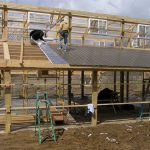Almost anything can be sold as a benefit…
Most post frame buildings are sold to the unsuspecting or ill-informed client based upon a set of features. These features may or may not have an actual benefit to the long term performance of the building. What is most unique is – the sales person often has no clue as to whether the feature has a benefit or not! They are just selling it as if it actually was beneficial.
 Case in point – one of our recent clients in Colorado has hired a building contractor to erect his building. This particular contractor happens to admit to sheathing over 90 percent of all of the post frame buildings he has put up in 7/16” OSB (Oriented Strand Board) beneath the steel roofing and siding. While this may sound great and wonderful (not to mention expensive), does it truly offer a benefit to the client?
Case in point – one of our recent clients in Colorado has hired a building contractor to erect his building. This particular contractor happens to admit to sheathing over 90 percent of all of the post frame buildings he has put up in 7/16” OSB (Oriented Strand Board) beneath the steel roofing and siding. While this may sound great and wonderful (not to mention expensive), does it truly offer a benefit to the client?
Think of roll formed steel roofing and siding as performing like a very strong, very thin plywood and you will have a better grasp of how it performs. The only reason to put OSB on a roof would be in the case of a very narrow, very long, very tall building with high wind loads – ones which would exceed the wind shear carrying capacity of the steel. This case is most certainly the exception to the general rule and happens in far less than 5% of all post frame buildings. Even in those cases, the OSB is only effective in the bays closest to the endwalls, where shear forces are greatest. As for the walls – on endwalls with a significant number of openings, it becomes necessary to reinforce the steel siding with OSB (generally at the corners). Outside of this, there would not be an economically practical reason to sheet the walls with OSB.
Let’s look at some numbers…
From the 2012 IBC (International Building Code) Table 2304.6.1 – over framing spaced 24 inches on center, 7/16” OSB fastened with 8d common nails six inches on center at the edges and in the field will support a maximum design wind speed (Vult) of 110 mph (miles per hour) in Exposure B or 90 mph in Exposure C. Table 2304.7(3) gives the 7/16” OSB the ability to carry a roof live load of 40 psf (pounds per square foot) when spanning the same 24 inches.
The 2009 IBC in Table 2306.2.1(1) gives the shear value for 7/16” OSB with 8d nails six inches on center as 230 pounds per foot for a Case 1 layup (long side of the panel towards the load, and joints staggered by four feet) in Douglas Fir, with an 18% reduction for use with SPF (Spruce-Pine-Fir) or Hem-Fir.
Compare this to 29 gauge steel. From information provided by Fabral (https://www.fabral.com/grandrib-3-load-tables/), spanning 24 inches the wind load is good for 213 psf. Converting psf to wind speed (P = .00256 x mph^2), would equate to 288 mph! For roof loads (gravity) 112 psf.
For shear loads – we actually tested 30 gauge steel (nearly 12% thinner than 29 gauge), over spans of 28 inches (nearly 17% greater than 24) and using SPF lumber. We were looking for a worst case scenario for roof applications. Without the use of sidelap stitch screws we obtained a tested value of 110 pounds per foot and with stitch screws 160 pounds per foot. These values are published in the NFBA Post Frame Building Design Manual.
Doing a little fuzzy math 160 X 1.17 (spacing adjustment) X 1.12 (thickness adjustment) X 1.18 (species adjustment) = 247 or roughly comparable to the OSB value!
So why would we even add OSB? Because in conjunction with the steel, the strength vales of the two products in withstanding wind shear can be added, up to twice the value of the lesser strength product.
Moral of the story – OSB has its place structurally in limited circumstances on post frame buildings, but to try to sell it in overall use as a benefit, just doesn’t hold true.







